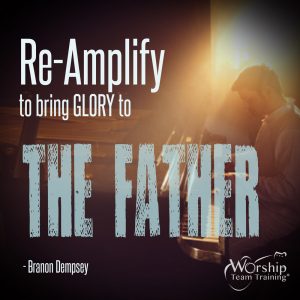Thursday Show
How To Re-Arrange Your Music (Show #40)
 #ReAmplifyYourSongs (Video Below) Repost of Show #40 As a worship leader and band, it’s easy to get bored of the songs you have. But how can you switch things up to be more creative? You never know the leverage of what a song can do by using what you already have.
#ReAmplifyYourSongs (Video Below) Repost of Show #40 As a worship leader and band, it’s easy to get bored of the songs you have. But how can you switch things up to be more creative? You never know the leverage of what a song can do by using what you already have.
So how do you re-amplify your songs to bring unscalable glory to God? Let’s take a look at a fairly new song to learn new ways to grow in color, sound and style. Ephesians 5.19 tells us: “Sing and make music from your heart to the Lord,” For a while now, the song “Good Good Father” by Housefires has been climbing the charts. Personally, I love this song because of the Chorus lyrics.
Also, I like the way the lyrics move along with the chord progression. For those who are not familiar with the song, do your self a favor and check it out. In the meantime, take a song you are familiar with and try applying these methods below. You can perform this method of arranging to just about any song.
Most people know the standard version of “Good Good Father;” just recently I found another version by the group Zeeland. In this post, I will cover a few changes Zeeland made to make this song have another fresh appeal. Also, I will offer a few new tricks you can try on your own – even if you know very little about arranging or writing music.
WATCH TUTORIAL BY BRANON DEMPSEY
1. Start Backwards Many times we as musicians/singers like to listen from beginning to end. However, have you ever asked yourself the question: what makes this song pop? Is it the melody, the drum groove, guitar riff, vocal harmony, etc?
I do a really weird thing I learned long a go – start backwards. Go through the song and find the part of the tune that sticks out. Play or sing the part by itself and unattached from the rest of the music. Next, identify where in the song you heard the pop. Is it found in the Verse, Chorus, Bridge, etc?
Afterwards, see what else is going on in the same section. How do the chords or lyrics relate to the part of the song that sticks out to you?
2. Chord Study In the song “Good Good Father” (GGF) let’s look at the basic chords. We will use this teaching example (post/video) in the key of G. Original Chord Progression: The Verse: G | Gsus | G | Gsus Pre Chorus is: C | G/B | Am7 | D4 Chorus: C2 | G | Am7 | D4 (repeat) Bridge: C2 | Em7 | Am7 | G C2 | Em7 | D4 First, let’s talk about the Verse. In the original version, I like the G pedal (we call it) because the G chord sustains throughout the verse. Why is this done?
Because the melody rides upon the G and builds tension to the song – from G to Gsus chords. (the inner note of the chord – the 3rd – moves to a 4th and back again to the 3rd). The G chord provides a very good solid foundation for the melody – it doesn’t move, it’s very stable.
Next, we move to the Pre Chorus. In this section, the chords shift from C to G/B – providing a lift like feeling. Then it moves to the Am7 (2nd Chord) and to the D4 (5th Chord). The melody also provides a lift quality and then builds towards the Chorus. As you enter the Chorus, you have this big wave that crashes down on the C (4th Chord) going back to the G (home 1 Chord). Great resolve and great release.
3. Change Up the Chords Here’s the new trick part to switch it up! Same song, begin with the verse. Notice the G Chord, as said before, it’s stable and we don’t want to change it too much. How can we do this? Look at the Chorus chord C.
Remember how I started off this article saying that this Chorus section is the main feature that sticks out to me? Well, there’s a reason. The 4th Note (C), in the key of G is a suspended note. The C adds tension to the G melody line. When it resolves, it has a very concluding and pleasing sound.
Let’s look at the spelling of the C chord. You have C – E – G (1, 3, 5).
VERSE:
What if we took the outlining of the C chord and made a progression out of it? This would not be a very popular way of a chord progression. On the surface, it may not seem very moving, or is it? Since the Verse pedals on G, let’s try borrowing the C chord and putting it into the verse.
However, we make each note a chord progression: G | Em | C | G (together these root chord notes spell out a C Major Chord) If you listen to the Zeeland version, this is exactly what they’ve done. Hear how the chords of: G | Em | C | G sound in the verse. It still starts and resolves to G, yet, it introduces a bit more color than the original version.
PRECHORUS:
In this section, they re-worked the: C | G/B | Am7 | D4 In my opinion, starting with a C chord is a bit overused on both the PreChorus and Chorus.
You can still have the tonal center in the frame of a C chord, but like we did on the verse, use other notes out of the chord to give the PreChorus more harmony. In example: the new PreChorus is: Am | G/B | C | D4 It’s just a simple walk-up the scale from the minor 2 Chord to the 5th.
The tonal center is still in C moving to D. This movement provides a bigger lift than the original without overusing the C Chord.
CHORUS:
The chord progression from this section is unchanged. *Please note, you do not have to change every chord in the song to make it new. Stray from changing up the Chorus sections too much. Reason: this is the section of the song in which most people sing.
If you mess with this – like an old hymn – it can throw familiarity out the window. Folks may be confused and will stop singing. What you can do?
Change up the instrumentation (like found in the Zeeland version), you can add more drums, rhythmic push, piano, more thunder in the bass, etc.
BRIDGE: as-is Progression: C2 | Em7 | Am7 | G C2 | Em7 | D4
ZEELAND ARRANGEMENT: VERSE: G | Em | C | G G | Em | C | G PRECHORUS: Am | G/B | C | D4 CHORUS: C2 | G | Am7 | D4 (repeat) BRIDGE: C2 | Em7 | Am7 | G C2 | Em7 | D4 ___________________________
BD (EXPANDED) ARRANGEMENT: VERSE: 1 chord per 2 bars Em | Em | C | C G | G | D4 | D4 PRECHORUS: Em7 | Em7 | C/G | D4 CHORUS: Am | G/B | C | D4 (repeat) BRIDGE: C2 | Em7 | Am7 | G C2 | Em7 | D4
4. Other Tricks of the Trade If you are not a music arranger, here are a few more easy ideas to change up your songs: Change up the Chorus Chords Don’t Play Every Note / Every Instrument Omit a few chords Try some new rhtythms Replace some instrument voices Begin the song on the Chorus or Bridge
“I will sing of steadfast love and justice; to you, O LORD, I will make music.” – Psalms 101.1
So let your songs be re-amplified and let your spirits soar. Make new fresh arrangements for God, make them fresh, keep it real and most of all…keep them singing.@BranonDempsey @worshiptt

Copyright 2016 Worship Team Training®









